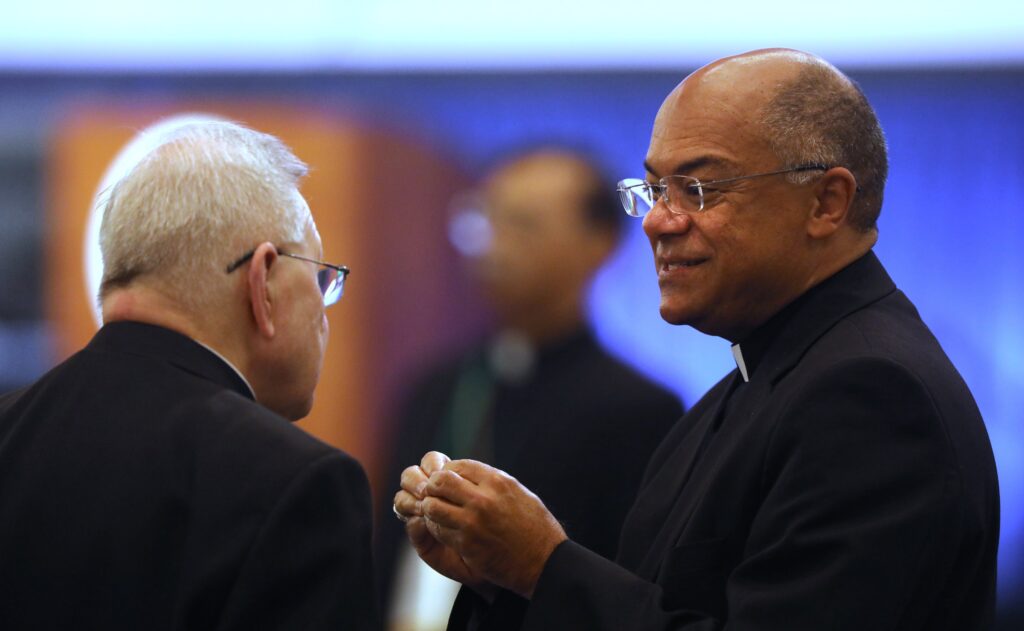
Business to Follow U.S. Bishops on Retreat This Summer
By: Our Sunday Visitor
Cardinal Timothy Dolan serves on the U.S. Conference of Catholic Bishops’ Committee on Religious Liberty

(OSV News) — Most Junes, the U.S. bishops convene for what is commonly called their spring plenary — a mid-year assembly to tend to affairs concerning their episcopal conference, and a way to move forward policies, plans, and committee work ahead of the more robust November plenary assembly.
This June, however, the ordinary work of a plenary assembly is set aside, leaving behind a business agenda for a triennial, weeklong retreat in California.
While some conference committees meet ahead of the gathering, the bishops are not scheduled to deal with ordinary business as a body. Still, there will be no shortage of items to talk about when the bishops are together. Since the bishops last met in Baltimore last November, the United States has sworn in a new president and the College of Cardinals has elected a new pope.
The early days of President Donald Trump’s second term brought many changes to the operations of the federal government’s USAID program, which in turn led to significant cuts to the federal dollars funding the conference’s migrant resettlement services. Widespread layoffs followed, significantly decreasing the USCCB workforce as well as the church’s ability to assist the federal government in resettling migrants in the U.S.
Despite these tensions with the Trump administration, some U.S. bishops have accepted the president’s invitation to serve as members of and advisers to a new commission on religious liberty Trump established in May.
While New York Cardinal Timothy M. Dolan and Bishop Robert E. Barron of Winona-Rochester, Minnesota, serve on the commission, Archbishop Salvatore J. Cordileone of San Francisco and Bishops Thomas J. Paprocki of Springfield, Illinois, and Kevin C. Rhoades of Fort Wayne-South Bend, Indiana, have agreed to serve the commission on an advisory board of religious leaders.
Who can effectively serve as a liaison with the Trump administration on behalf of the body of U.S. bishops at this critical juncture is likely to top consideration for who will be put forward to take the reins of the bishops’ conference, as conference membership will itself be electing a new president and vice president in Baltimore this fall.
With Archbishop Timothy P. Broglio of the U.S. Archdiocese of Military Services wrapping up his three-year term as conference president at the end of the upcoming November assembly, longtime tradition dictates that the incumbent vice president would be on the ballot as presumed successor. But the tradition of electing vice presidents as presidents has been broken in recent years, as the age of such bishops has made them ineligible to stand for the presidency.
Archbishop William E. Lori of Baltimore, whose term as vice president ends after the November plenary, recently turned 74 and is therefore ineligible to stand for the presidency since he could not complete a three-year term as president before he turns 75, the age at which canon law requires bishops to submit their resignation to the pope.
Not only will the bishops’ relationship with the White House be a significant factor in choosing new conference leadership later this year, but also the emerging priorities and vision of the new successor of Peter.
Pope Francis’ death on April 21 and Pope Leo XIV’s election on May 8 have brought about, if nothing else, a change in the status quo. Pope Leo’s first month has indicated a shift to a calmer, less frenetic pontificate. While bishops often turn to the pope as a model for priorities and plans, it remains to be seen how Pope Leo’s emerging and fresh approach to Petrine ministry will be interpreted and implemented among the U.S. episcopate.
In the first month of his pontificate, Leo named two men for the episcopate — an auxiliary for the Archdiocese of Newark, New Jersey, and a bishop to head the Diocese of Houma-Thibodaux, Louisiana — and elevated two auxiliary bishops to serve as diocesan bishops: San Diego and Pittsburgh. At least two of these appointments, if not all four, were in progress before Pope Leo’s election, and likely do not offer any papal tea leaves to be read.
More significantly, it remains unclear which, if any, U.S. bishops are close to Pope Leo or might be relied upon as American point men in his pontificate. One key factor in deciding this will likely be who the former Cardinal Robert F. Prevost nominates to take his place as prefect of the Dicastery for Bishops.
Although Leo is the first U.S.-born pope, he has very little experience in common with most U.S. bishops. A Chicago native, Pope Leo has few ties to American bishops and never held membership at the U.S. bishops’ conference. Much of his priestly ministry was spent outside of the States, notably in Rome for a dozen years where he served as prior general of the Augustinian order, and in Peru, where he served both as a priest and later as a diocesan bishop for just under a decade.
Pope Leo’s emphasis on ecclesial unity in the early days of his pontificate came in the wake of new divisions that arose under his predecessor’s tenure. While many U.S. bishops were not eager to enforce the strict rules promulgated by Pope Francis about the celebration of the Mass according to the 1962 Roman Missal, the way some have implemented the pertinent legal restrictions has inflicted new wounds.
Most recently, Bishop Michael T. Martin of Charlotte, North Carolina, decided to confine the use of the 1962 Missal — what is often referred to as the traditional Latin Mass, also known as TLM — to one locale, with little consultation or preparation. This news came just before a draft letter had been leaked in which Bishop Martin outlined a potential widespread liturgical change to his diocese — which many have criticized as overly polemical, ideological, and divisive — the likes of which have not been seen for decades.
After a massive outcry, Bishop Martin decided to postpone the movement of the TLM to the central locale, adding the caution that if Rome decided to change Pope Francis’ directives, he would comply. He also reportedly shelved the drafted document.
The episode in Charlotte comes as the National Eucharistic Revival draws to an end. While the National Eucharistic Congress in Indianapolis last July and the corresponding pilgrimage were widely regarded as successes, the revival itself has largely fallen flat, implemented in each diocese to varying degrees and never given much heft from Rome.
The U.S. bishops’ signature priority of the last several years — the efforts of the church in the U.S. to refocus and sharpen Eucharistic devotion and Eucharistic living — hobbled along among renewed liturgical wars, such as those instigated in the latest Charlotte fiasco, and more often surfaced ideological in-fighting rather than effected greater ecclesial unity.
The three-year revival comes to an end in Los Angeles on the feast of Corpus Christi, as the bishops conclude their retreat in the same state — perhaps a setting for the bishops to reflect on the successes and missed opportunities of the effort overall.
Finally, a large number of bishops — though not all — find themselves now presiding over institutional and fiscal decline and a shrinking footprint. This is most recently evidenced in the Archdiocese of Washington, which, plagued with scandal and financial collapse, laid off about one-quarter of its chancery staff on June 5, including some in high-profile positions. So too in Buffalo, New York, where it has been announced that parishes are expected to absorb nearly half of a proposed bankruptcy settlement related to clergy sexual abuse.
During such challenging times, and considering their jam-packed schedules of daily ministry, the rare occasion to spend time in each other’s company to foster greater unity in spirit and purpose and together navigate the changing landscape in which they now minister is no doubt welcome. The faithful should pray that a week of retreat in sunny California allows the bishops to build up fraternity and bolster the spiritual growth needed to strengthen their ministry.
Ideally, too, they will use the opportunity as a launching pad for a new era of leadership for the U.S. bishops to be born. The results of November’s plenary assembly elections will be what bears testimony as to its effectiveness.
– – –
Michael R. Heinlein writes for OSV News from Indiana.

